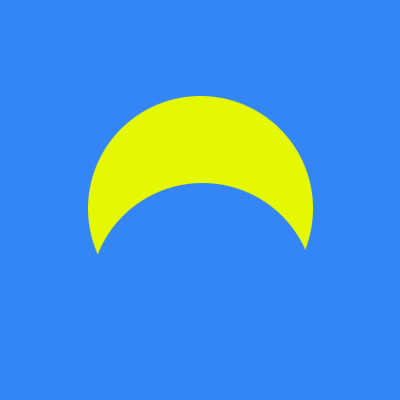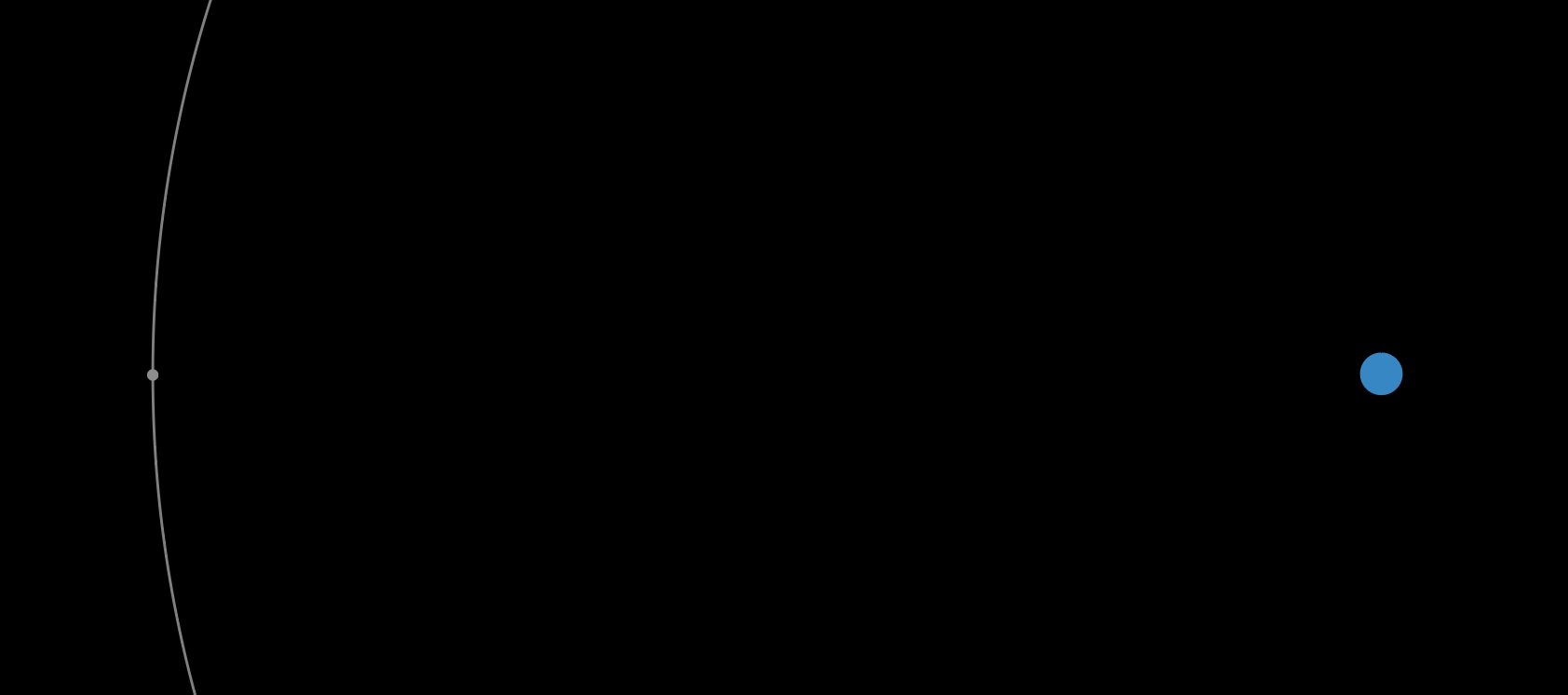What is a total solar eclipse?
Based on questions we've received at eclipse2024.org, it's not at all out of line for us to give a VERY basic overview of the makings of a total solar eclipse! This is important stuff; it's all too easy for eclipse veterans to forget that most people have never seen a total solar eclipse, and would really appreciate a clear description of what is going on in the sky!
Solar eclipses in general
Solar eclipses are eclipses where the Moon goes in between the Earth and the Sun, and passes right "in front of" the Sun as seen from the Earth. When this happens, the Moon partially or completely blocks out the Sun’s light, and we see that here on Earth as a very interesting and unusual phenomenon. Here is the traditional picture everybody uses of this situation:

It’s VERY important to remember that this picture is NOT drawn to scale! The Earth really isn’t almost as big as the Sun! But this is the drawing everybody always gives, and we need some kind of drawing that fits on the page, in order to show you what’s going on. More on this later; for now, the drawing does serve our purpose, so let’s just pretend for a minute that this is what things really look like.
Partial phases and eye safety
The Sun is very bright, and even though the Moon might be passing in front of it, at most places on Earth there will always still be a part of the Sun that the Moon isn't covering up. Unlike with a lunar eclipse, the whole daytime side of the Earth is NEVER going to see the Sun completely covered up! In the diagram, you can see there is a lot of Earth that is not seeing any of the Moon’s shadow at all. People in this light blue area will not see any eclipse at all.
Then, there is a big light gray circle that takes up about half of the Earth’s surface. People in this area will see the Moon covering a piece of the Sun, but not all of it – they will see a partial eclipse.
SO LONG AS ANY BRIGHT PART of the Sun is still able to be seen – regardless of whether the Moon is covering other parts of it up – it is still just as dangerous to look at the Sun as it would be during any other (non-eclipse) time! You simply can't look directly at the Sun without CERTIFIED eye protection (usually "eclipse glasses") during a solar eclipse, unless ALL of the Sun is being covered by the Moon. And that requires a very special set of circumstances!
The path of totality
Let’s see what that “path of totality” thing is. In the video below, you see a top view this time; we’re stationed above the north pole, and the Moon is moving in its orbit from “left to right” around the Earth, which from our vantage point means “top to bottom”. See how that little circle of shadow moves across the face of the Earth, and marks out a “path” of totality.
Let’s note a couple of things here: First, the drawing is not to scale (as usual). Second, this whole business of the shadow moving all the way across the Earth’s surface takes about 3 to 4 hours. Third, there is a little white dot at the very tip of the shadow cone. That dot doesn’t represent anything except the tip of the cone, but will be an item of interest when we discuss other types of eclipses. And finally, note that it’s important to know where you are on Earth to know what kind of eclipse you’re going to see, and when it’s going to happen. If you’re somewhere that the Moon’s shadow is going to be at some point in time, then you’ll see totality – you’re “in the path”! If you’re at the eastern part of the path (the bottom in this view), you’ll see totality later than someone who is west of you, because of the Moon’s movement in its orbit (dragging its shadow behind it as it goes).
But if you’re not in the path – if you’re somewhere on Earth that the shadow is never going to touch – then you won’t see totality at all. The best you’ll be able to see is a partial eclipse.
A "total" solar eclipse
Important definition: Astronomers call an eclipse a “total” eclipse if there is any place on Earth that will see totality. We know that most people on Earth won’t see any eclipse, and lots more people will only see the partial phases of the eclipse. But because there are places on Earth you could go that are in the path, where you would see totality from, THAT’S why this eclipse is called a “total” eclipse. Just remember that it’s NOT total for everyone!
Let’s note that the Moon’s shadow in space kind of looks like a cone, though it’s hard to see in this view. Here is another view of the shadow projected out from the Moon and moving across the Earth, this time with a true “left to right” perspective just like in real life. Note that in this video, the Earth is NOT moving; WE are moving from left to right a little faster than the Moon, so we can see the shadow touching the edges of the Earth on both sides of the path. That’s why it looks like the Earth is moving against the stars – but it’s really not.
Let’s also notice what’s happening at the places where the shadow first touches the Earth, and where it leaves. (Remember that the Earth is rotating while all this shadow movement is going on, and that rotation is from “left to right” in this view.) Since the axis of the Moon’s shadow is pointed directly at the Sun, you can see that its first point of contact with the Earth takes place at a point on Earth that has just rotated enough so that the Sun is visible. At that point, the Sun is rising. Similarly, on the back end of the eclipse, the shadow last touches the Earth at a point that is rotating away from being able to view the Sun. This means the shadow is lifting off the Earth at a point experiencing local sunset. Views of totality from the sunrise/sunset points are very rare, and we understand they are quite beautiful. For the 2024 eclipse, those points occur in open ocean, and it is doubtful that anyone will actually observe the eclipse from them.

Totality begins at local sunrise…

…and ends at local sunset
And from now on, let’s call the Moon’s shadow what astronomers call it: the “Umbra”. This Latin word gives rise to the Spanish “sombra”, the French “sombre”, the Italian “ombra”, and the English word “umbrella” (Get it? You’re in the ‘ little shadow’ of the rain!)
If you're in the path
Let’s now look at three observers on Earth, somewhere in the middle of the path, and see what they see:

Again we have our “very much not to scale” drawing, which is good enough for our purposes for right now. This time, we’ve drawn the entire path of totality across the Earth, and have frozen one moment in time where the umbra is being cast upon the lucky observer at point B. This person will be seeing totality, for as long as it takes the Moon to move enough for the umbra to pass over their particular observing location. This is called the “duration” of totality, and that duration depends on where the observer is along the path! (Points in the middle of the path get more duration than points at either end.) Observer B will experience all the amazing things that go along with totality.
If you're not in the path
But what about observers at points A and C? It doesn’t look like they will EVER get to see totality, because they aren’t in the path. We’ll assume that they are not too far from the path – or else they wouldn’t even be able to see a partial eclipse. At this particular moment, while B is seeing a total eclipse, observer A is too far north; from this vantage point, A can see the Sun (through their eclipse glasses!) peeking over the “top” of the Moon, and it looks something like this:

Observer C is seeing the bottom part of the Sun, because from this perspective, the Moon has gone “too high” over the Sun’s disk to block it all out:

Neither one of them sees totality, because they weren’t in the path!
Also, make sure you understand that the farther away from the path these observers are, the less and less of the Sun will be covered – even at the time of maximum coverage. Eventually, we could move so far away from the path that we wouldn’t see any eclipse at all.
(And yes, the position of the Moon in the sky does in fact depend this much on where you’re located on Earth!)
Magnitude and Obscuration
By the way, if all you’re going to see is a partial eclipse, then there will be time when a maximum amount of Sun will be covered. Let’s say it’s 50%, kind of like in the pictures above. We say that you’re experiencing a “50% partial” eclipse in that case. That doesn’t mean you’re seeing only half of a partial eclipse, though! It’s just a shorthand way of saying that 50% of the Sun’s diameter is covered by the Moon. And if you want to get more technical, astronomers make a distinction between Magnitude (amount of the Sun’s DIAMETER that’s covered) and Obscuration (the amount of the Sun’s apparent AREA that’s covered). Those numbers are not the same (except at 0%); 50% magnitude equals about 40% obscuration, and doing some geometry can give you the conversions between the two for other values (but be warned – you have to know the relative apparent diameters of the Sun and the Moon to get exact values, and those are not the same for every eclipse!)
There are still a lot of questions to answer, such as:
- Why does the eclipse go from west to east across the Earth?
- What other kinds of eclipses are there?
- What’s a lunar eclipse?
- Why don’t eclipses happen every month?
- Why does totality last longer for some eclipses than for others?
- Why do I need to be near the centerline of the path?
We’ll get to all of these, and you can read all about them using the links above. But first, we lamented earlier about the scale of our diagrams not being accurate. Let’s look at some diagrams that show you the true scale of the eclipse situation. These drawings are very close to the ACTUAL scale of the Sun/Earth/Moon system, and should be kept in mind whenever you’re seeing anything that says “diagram not to scale”! This will help give us some perspective for our next discussions.
The true scale of the shadow
First, here is a drawing that shows the Sun, Moon and Earth all in the same picture. (We’ll show Earth’s orbit as well, just for good measure):

Do you only see two things in the picture? Yeah, us too. The yellow dot at left is the Sun, but what’s that over on the right? It looks like a dot – like we’ve left out the Moon completely. Let’s zoom in on that piece at the right, and see:

Ah, NOW we can see that there’s a blue dot (the Earth) in the middle of a tiny circle. Well, that circle is the Moon’s orbit around the Earth! Go back and forth between these two pictures, to get an idea of the scale we’re talking about. When we’re using the Earth-Moon system as our scale, the Sun is really far away, and it’s REALLY big in comparison.
In this view, it looks like the Moon is really close to the Earth, so let’s zoom in again to get an idea of the scale of the Earth-Moon system:

Now we can see the Earth and Moon with sizes and distances to scale! Remembering that this picture is expanded from that tiny little piece of the first diagram really gives you an idea of the geometry of the situation – and it shows how silly the “diagram not to scale” diagrams really are! They give NO SENSE at all of the huge amount of distance involved when we’re talking about that tiny Moon projecting a VERY long shadow from the VERY far away Sun, which just happens to strike the very remote Earth.
Here’s the Moon’s shadow with the Earth, drawn to scale:

That very long, very thin (but still conical) shadow is what the Moon is projecting out into space, that has to hit the earth to create an eclipse. At this scale, we can start to appreciate how rare an eclipse really is, and this will launch our discussion into why eclipses doesn’t happen every month.
Remember, even with this really thin shadow projecting so far out into space, onto an Earth that we now see is pretty small in comparison, we can calculate not only when an eclipse is going to occur, but we can determine the actual path that the umbra is going to take as it scrapes its way over Earth’s surface – and we can do it all VERY accurately. How accurately? Within a couple hundred yards, to within fractions of a second! And all because of math! If you’re interested to take a deeper dive, we’ve written up some of the background material you’ll need to know, in order to appreciate and understand more about how these “eclipse circumstances” are calculated.

